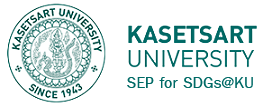
According to Kasetsart University’s announcement, energy conservation policy has been established as guidelines for all departments within the University for the efficient use of electricity, which is the main energy source in the operation of the university’s activities. Various measures are determined, such as the environmentally friendly design of buildings or structures or smart building using the Building Automation System (BAS) to manage energy within the building along with raising awareness of students and personnel in matters of energy conservation together with the policy of using more energy efficient electrical appliances to reduce energy consumption with the goal to replace 80 percent of all electrical appliances.
Finding alternative energy sources is another measure to reduce the use of electricity from fossil sources, such as Solar Power, Wind Power, Clean Biomass, Biogas, with a focus on being clean and environmentally friendly as well as indirectly reducing greenhouse gas emissions.
[2.9] Elements of green building implementation as reflected in all construction and renovation policies.
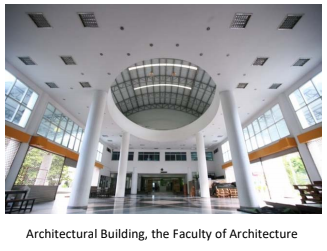
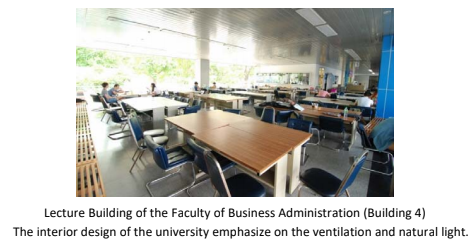
1. The design of the building for ventilation and natural light.
Library in the Park
The Office of the University Library created area between buildings as “Library in the Park” 1so that students can sit and relax in natural site.
To respond to the “Green Campus” policy, the Office of the University Library renovated 475 square metres of space (which was damaged from mega flood incident in 2011) within the office to be “Library in the Park”‐ reading area in natural atmosphere and saving energy for student and staff.Moreover, the Office separated space within the Library in the Park as a site of special event such as “Music in the Park” among variety of botanical garden which comprised of 2 species of plant: Acanthaceaeand Bignoniaceae.

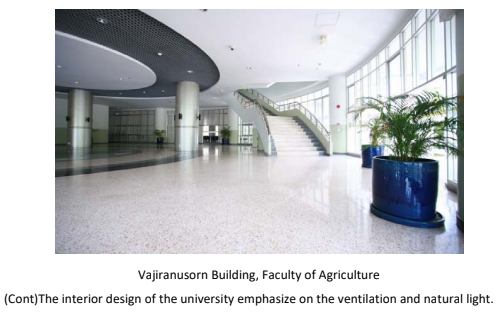
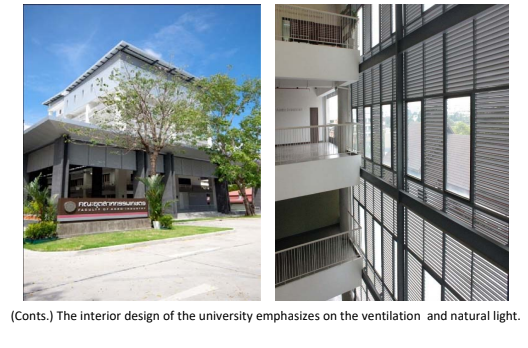
Agro‐industry Research Operation Building: saving energy building ventilates fresh air inside without air‐conditioner and uses transparent windows and walls to save electrical energy.
2. The Faculties/Offices of Kasetsart University appointed a sub‐committee on energy management to set a policy and plan of energy conservation approach that follow the university’s overall plan and appointed managers of building who can conduct efficiently the plan.




Kasetsart University Library/Learning Center (KULC) wins the Thailand Energy Awards 2018
Kasetsart University Library/Learning Center (KULC) wins the Thailand Energy Awards 2018 for concept of energy efficient building. Dr. Anamai Damnet, Vice President for Special Projects and Suphan Buri Establishment Campus Project, received the award plaque from Deputy Prime Minister of Thailand Air Chief Marshal Prajin Juntong, The library representative including Dr. Aree Thunkijjanukij and staff of library participated in the award ceremony.
Kasetsart University Library/Learning Center (KULC) has been promoting the energy conservation in the library building since 2015‐2017, such as installation of paper pulp roof insulation, replacing LED lamps, installing pull‐chain light fixtures, installing air exchanger & ventilator equipment. Overall it helps saving the energy up to 501,973 kWh.
In addition, the 7S Model for Organization Improvement and thetransferring of technology and knowledge among 10 members of the Green Library Network have also been implemented. The Thailand Energy Awards 2018, the Department of Alternative Energy Development and Efficiency organized the contest to honor those who have outstanding performance in energy conservation and alternative energy development.It promotes awareness of energy conservation and promotes the development of alternative energy. It also creates awareness for those who are involved in applying for sustainable development.
Kasetsart University Library Office organized the training on energy and environmental management project for library’s personnel and users, according to UI Green Metric criteria. This program was held to promote various activities related to energy and environmental conservation, in accordance with the ranking criteria of the UI GreenMetrics Ranking.
3. The building was rewared which related to the design as the energy consevation building.
The design of a new building of the Faculty of Engineering at KamphaengSaen received award from the Department of Alternative Energy Development and Efficiency (DEDE).
This design passed the Building Energy Code (BEC), standard criteria for efficient energy consumption buildingevaluation which accredited by DEDE.


4. Bidyalankarana Learning Center building, Faculty of Economics, Kasetsart University received “BEC Awards 2018”. This is the label for energy efficiency standard of new building design.
The Department of Alternative Energy Development and Efficiency (DEDE) offered the “BEC Awards 2018” to 18 buildings that met the Building Energy Code (BEC) design standard for energy conservation. In 2018, there were only 18 buildings out of 114 buildings from 33 organization were inspected and certified from DEDE.
Bidyalankarana Learning Center building of Faculty of Economics, Kasetsart University is a ‐13storey building. It has an area of 22,979 square meters, with a height of 69.5 meters and WWR 20% of ratio. This building can save 54% of energy and received a very good building rating.
NZEB building needs to generate renewable electricity to replace the external electricity for the zero net energy usage. The renewable energy in present time is focusing on solar energy. For example, installing solar panels on the ground, which is a waste of space and cannot be used for any other purposes. Another option is to install solar roof, which requires a lot of money to improve the roof structure for old buildings without rooftop. However, even when using the entire roof area, it is
still not enough to produce electricity for this museum. Therefore, the latest innovation of Floating Solar Technology is used. There are many advantages of the technology as follows.
*Floating Solar is not a waste of space with no roof renovation required. It has the efficiency of producing electricity 5‐15% higher because the water helps to reduce the panel temperature.
*Floating Solar reduces sunlight exposure into the water, which reduces the chance of plankton bloom in ponds (water gone green or bad), and reduces evaporation by up to 80% (of the area under solar panels), which is important for ponds that rely only on rain water source.
*Floating Solar panel is also easy to install and disassemble, which is not required very high cost.
This is not only the world’s first museum that adopted the latest solar panel technology to the museum by Floating Solar for NZEB Museum, but it is also an experiment with floating solar in swamp areas, which most of Thai cases can apply the knowledge easily.
NZEB building and floating solar panels are often used as a model for learning. When both NZEB and Floating Solar are in the same place, it means 1 + 1 = 2. However, at the Faculty of Fisheries, we have another important place, which is the location of Kasetsart University Bang Khen, where there are ten thousand more students as well as many government agencies in the university area. The university is also located in the center of Bangkok with the BTS Skytrain and the Red Line Subway on both left and right side, making the transportation for visiting the project very easy. It also means a large number of farmers who regularly attend trainings in faculties / universities and thousands of foreign students / researchers / foreign professors who come to study / conference / visit the project. Importantly, hundreds of permanent floating solar panels like these cannot be found anywhere in Bangkok.
Therefore, this place is …….
The World’s First NZEB Museum
The World’s First Floating Solar for NZEB
Bangkok’s First Floating Solar
The fish pond of the future has 5 zones
Zone 1 ‐ Smart Pond – A large pond with enough surface area, and proper nutrients that flows into ponds of various animals, Siamese giant carp fish, giant gourami fish, soft‐shelled turtle, fish‐eating snake, egret bird, etc., causing natural balance without the need for breeding.
This type of pond is great for sufficient fishing for one or two fishes per person a day as a great protein supplement for family, not for great fish quantities in one single catch.
Zone 2 ‐ Prototype Fish Cage – This type of fish cage is for high price fish farming with the right amount of fish, not for too much fish quantities. It uses the water mass in the pond to control the quality. Each catch can make sale. It may not be very rich at once, but yearly catch is enough to afford your child education.
Zone 3 ‐ Floating Solar – Floating Solar generates electricity from sunlight with no space wasted. The low temperature under the panel increases efficiency by 15%, and reduces the evaporation of water under the panel by 80%. It helps to keep water in the dry season. There must be suitable areas for the panels, not the whole pond. It is important to keep a relatively small area to receive natural light.
Zone 4 ‐ NZEB or Net Zero Energy Building does not emit greenhouse gases (overall). The Faculty of Fisheries works this project with the museum building, but it can be applied to a wide variety of other buildings, which may not be a net zero energy usage like this, but can be energy saving buildings with the use of renewable electricity as much as possible to reduce electricity bills by ten thousands per month. It also is equipped with a green energy information center.
Zone 5 ‐ Green Lane ‐ Everyone likes bird and fish watching, natural observation, walking along the waterfront in the evening, doing exercise, running, or biking on weekends. Parents take their children to learn about the Thai future community. Around the pond, there is a beautiful fish center, prototype factory, fishery product, etc.
Why is the NZEB (Net Zero Energy Building)?
It started with global warming as a cause of greenhouse gases emitted from the use of electric power from fossil fuels. We therefore design / renovate an energy saving building as a Net Zero Energy Building (NZEB).
This type of building can generate as much electricity from renewable sources as the electricity used in the building, which NZEB causes no greenhouse gas emission.
The NZEB is being mentioned in the world. There are some prototypes in Thailand. For example, Khon Kaen University that renovates an old building in organizational communication as NZEB.
In the Faculty of Fisheries, we have the Museum of Fishery Natural Science, where there are more than 350,000 samples of aquatic animals kept and collected since 1923 as one of ASEAN best museum in this field. When searching further, it is found that there is no museum in Thailand or even in the world (as far as can be researched) can named itself as 100% greenhouse gas free museum, which is the reason this museum was selected to be renovated as NZEB.
5. Kasetsart University has a policy on increasing green area inside and outside of the building.
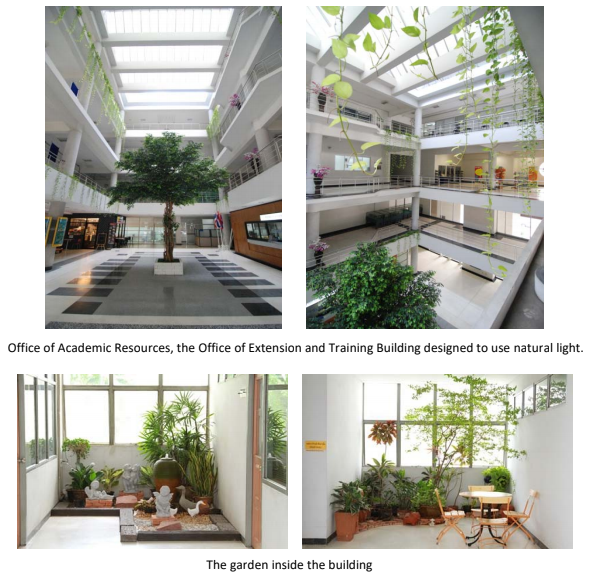


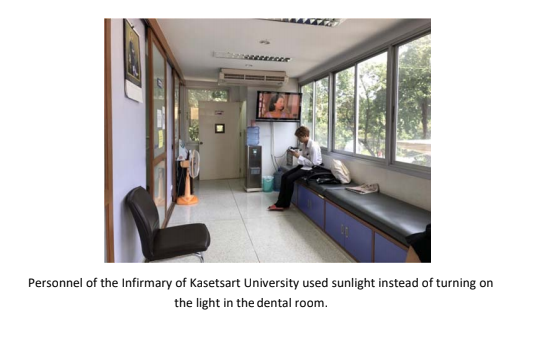
According to a criteria of Thai Green Building, Kasetsart University has a policy to preserve green spaces by requiring new building size 1,000 square meters or more to have a green roof, green wall or install solar energy, at least 50% of the green roof area totally. All buildings in the university will have natural ventilation system, using a translucent roof, using of shading materials to reduce heat entering the building, and planting trees on the roof. As for the master plan of the university, the buildings that was constructed before, will be renovated. It is another challenge to improve the building to meet the green building criteria.
Demanding of energy‐saving and environmental friendly buildings is increasing in all parts of the country as of the support, promotion and supervision of the government. According to a policy on energy conservation promotion and the Ministerial Regulations on the design of energy conservation buildings issuing in 2009 until reissuing in 2013, the Department of City Planning and Urban Development, Bangkok Metropolitan Administration has issued a new city plan. Which clearly requires that the new building will have to build as environmental friendly in both energy and water saving, as well as increasing green space. This is an opportunity for Kasetsart University to issue regulations on building construction which must be environmental friendly, electricity saving, and remain natural in the area. In addition, using all resources in the building worthwhile and to be a source of learning and observing of students and personnel.
